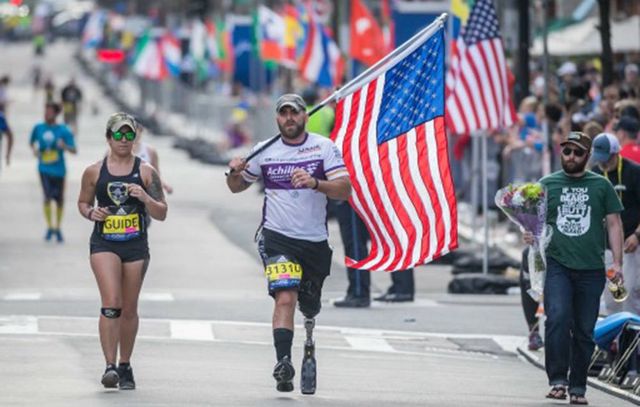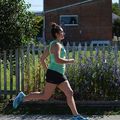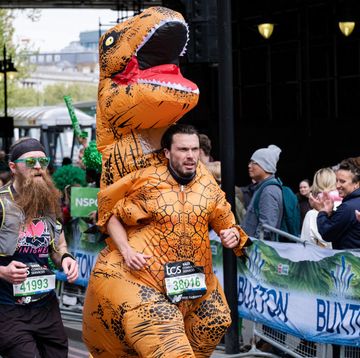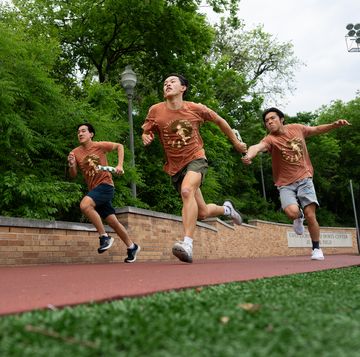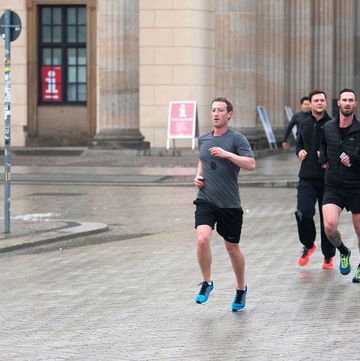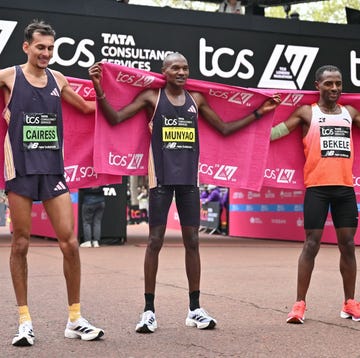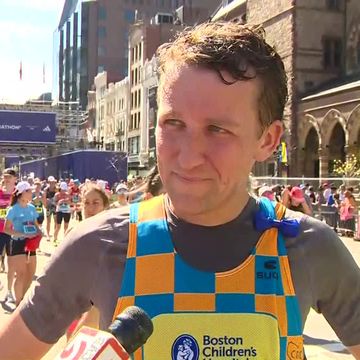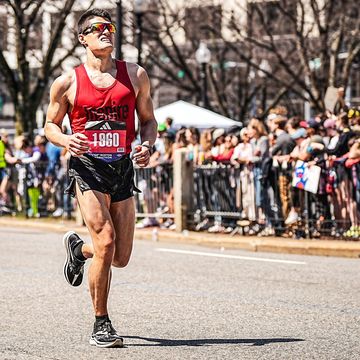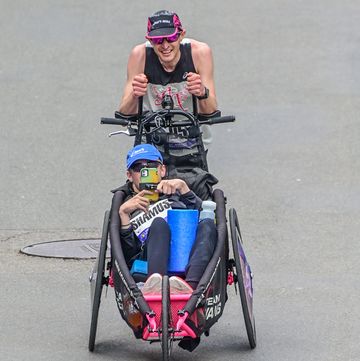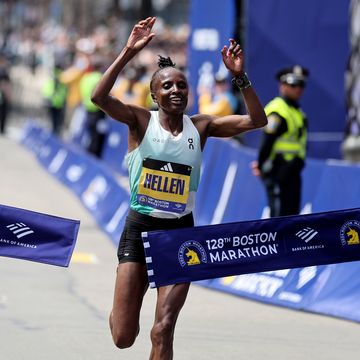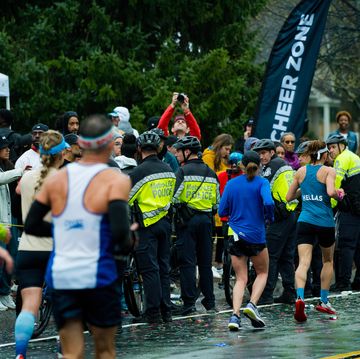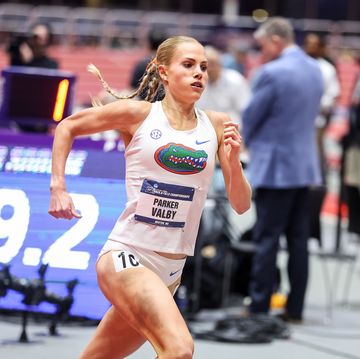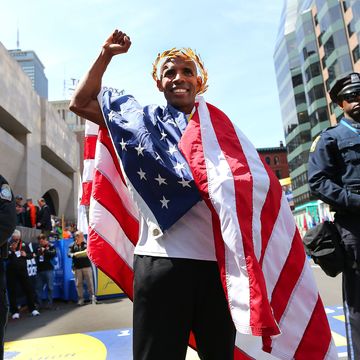Earl Granville has always been a runner, but it was never something he truly loved until he was faced with the prospect of not being able to do it anymore.
The 33-year-old joined the Pennsylvania Army National Guard right out of high school 15 years ago. Then in 2008, while deployed in Afghanistan, a roadside bomb hit the infantryman’s vehicle. The blast resulted in the amputation of his left leg above the knee.
His right leg was also severely damaged and he faced many rounds of surgeries before he could begin the process of learning how to stand, then walk, then run.
“I learned to walk on the parallel bars in physical therapy, then I transitioned to a walker, then a cane, then crutches,” Granville told Runner’s World by phone. “But with running, you just have to go. You’re going to fall once in awhile, but you just have to get back up and keep going.”
RELATED: After a Roadside Bomb Cost Him His Limbs, This Veteran Runs On
He started on a small track with a harness attached to a rope on the ceiling and soon transitioned to running on his own outside. Granville started to see running as something more than just military training and was able to do a few miles at a time.
“I became more excited about running after I lost my leg because I felt like I had something to prove to myself.”
It’s a story that we tell often—a runner who serves his country and has to transition back into life as they once knew it. It’s never an easy transition, especially in Granville’s case when, in 2010, a second tragedy struck. His twin brother, Joe, committed suicide while on active duty in the army.
The news struck him hard—Joe was the reason he signed up for the military in the first place—and his life went in a downward spiral.
“I started making some really unhealthy decisions and was just not being a good person,” Granville said.
His running journey truly began a few months later when he learned from some of his friends that his brother was extremely proud of all he’d accomplished after losing his leg, especially excelling at adaptive sports.
“When I found out how proud Joe was of me, I decided I needed to take another direction with my life,” Granville said.
So he started running some 5Ks and became more active with the Achilles Freedom Team of Wounded Veterans, which encourages vets to get involved in racing and eventually complete a marathon.
Granville finished his first marathon—the New York City Marathon—that same year with a handbike, and was hooked. He continued to either handbike full marathons or run the relay portion of them, when in 2015, he watched one of his Achilles Freedom teammates, who is a double-leg amputee, run across the finish line of the Detroit Half Marathon.
“I was pretty inspired by that, and I decided I was going to run a half marathon, too,” Granville said.
And he did. He still had some residual pain in his leg while training, but it was tolerable, so he kept at it, first completing the Disney Half Marathon and then the All-American Half Marathon.
Months later, Granville was craving a new challenge. Around this time, he met Andi Piscopo, who would later become his guide, at a Spartan Race. They connected right away, and anytime Granville does something hardcore, she’s his go-to.
“I ended up handbiking the Boston Marathon in 2016, and that same teammate ran it. I waited for him at the finish line after I was done, and he told me I had to run it the next year, and that was it. I said, ‘You got it, buddy.’”
To prepare for Boston, he ran about 15 miles per week and walked on the treadmill with a weighted backpack (20 to 35 pounds) with the incline set to 15 percent.
“With a high incline going 4.5 mph for one or two miles, it really gets your heart rate going,” Granville said. “I feel like that really helped me a lot.”
Don't Miss: Great Stories Delivered To Your Inbox
He knew he wanted to run with the American flag to honor the city after the bombings in 2013. So the night before this year’s race, he made a trip to Home Depot for one of the flags you might hang on your front porch. Although it was only made from a thin, plastic pole, Granville said the size of it got cumbersome to run with after a while, so he and his guide, Piscopo—who signed on to do the full marathon with him without hesitation—switched on and off to carry it.
Throughout the 26.2 miles, Granville’s legs cramped up. He even had to stop at the medical tent four times—but that didn’t stop him from achieving what he set out to do.
“I told Andi, ‘We can either quit or we can walk, and I’m not going to quit, so I hope you’re in this for the long haul.’”
As the pair neared the finish line after nine hours on the course, Granville felt a wave of electricity from the crowd. He realized the cheers were for him. As adrenaline took over, he hoisted Piscopo over his shoulders and carried her to the end.
“Even though I was cramping up, I knew I had to finish strong,” he said. “You just can’t walk over the finish line even if you’re in pain. So to add a little flavor, I picked her up and carried her over.”
Granville’s first thought after finishing the first marathon he’d ever run? That it’s time for another.
“My first reaction was that this was another milestone completed, so now I have to make a new goal.”
And although he has plans to run the New York City Marathon next, he’d ultimately like to attempt something a little different.
“I wouldn’t mind climbing a mountain someday, either,” Granville said. “The sky’s the limit.”
In the meantime, Granville will continue his work as a public speaker, helping others battle mental adversity, something he did, but his brother unfortunately couldn’t.
“I talk about finding that new purpose and passion, like I found running. Your life isn’t over once you get out of the military. You just have to refill those voids, and again, be part of something bigger than yourself.”
